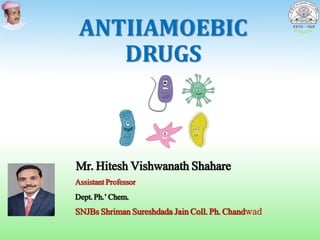Antiamoebics-Shahare HV
- 1. âĒ Mr. Hitesh Vishwanath Shahare âĒ Assistant Professor âĒ Dept. Ph.â Chem. âĒ SNJBs Shriman Sureshdada Jain Coll. Ph. Chandwad ANTIIAMOEBIC DRUGS
- 2. Learners will be able to know; 1. Introduction 2. Classification 3. SAR & MOA 4. Marketed Preparations 4 3 2 1
- 3. Protozoal Infection Unicellular protozoal cells have metabolic processes closer to human cells than bacteria ïąProtozoal infections are less easily treated than bacterial infections: Protozoal Infections Malaria Amoebiasis Leishmaniasis Trypanosomiasis Trichomoniasis Giardiasis
- 4. Amoebiasis ïą Causative agent: Protozoal parasite ïą Amoebiasis: Infection of Large Intestine : Entamoeba histolytica Cyst Tropozoites - Not active - Survive outside of Host Body -Tissue lysis of wall of intestine Diarrhoea Dysentery -Presence of Blood & mucous in stools -Abdominal Pain Parasite invade to blood vessels & Causes problems in Liver & Brain: Leads to death of Host Exist in 2 Forms
- 9. Binds to proteins and DNA, resulting in cell death Metronidazole is a Prodrug that is reduced in the cytoplasm by a Nitroreductase enzyme; resulting toxic intermediates disrupt nucleic acid structure. 9
- 10. Metabolism: In the liver, metabolism of metronidazole leads to two major metabolites, hydroxylation of the 2-methyl group to 2- hydroxymethyl metronidazole and oxidation to metronidazole acetic acid (MAA) 10
- 13. ï§ Mechanism of action is similar to that of Metronidazole ï§ Used in the treatment of intestinal and hepatic Amoebiasis ï§ Greater efficacy than Metronidazole . Tinidazole 1-Chloro-3-(2-methyl-5-nitro-1H-imidazol-1-yl)propan-2-ol Ornidazole 1-(2-ethylsulfonylethyl)-2-methyl-5-nitro-imidazole
- 14. Dichloroacetamide Derivatives ï§ Mechanism of Action: ï§ Side effects: Flatulence, Vomitting ï§ Effective in Intestinal, Luminal and local Amoebiasis Diloxanide Furoate 4-[(Dichloroacetyl)(methyl)amino]phenyl furan-2-carboxylateDiloxanide
- 16. Alkaloids Emetine Dehydroemetine ïą Differ only in a double bond next to the ethyl substituent Alkaloid derived from Cephaelis ipecacuanha Synthetic analog Less side effects ïą Parenterally administered (IM/SC), by oral route cause vomiting ïą MOA: Inhibiting intra-ribosomal translocation of tRNA-amino acid complex â Inhibition of Protein Synthesis
- 17. 1. Emetine Possesses a skeleton with two Tetrahydoisoquinoloine ring system and a Terpenoidal portion. 2. Psychotrine is a phenolic. It gives Emetine on reduction followed by methylation. 3. Emetine is non Phenolic moiety. 4. N-5 and C-9 are critical positions : Essential for Biological activities Chemistry 17
- 18. 1. Local stimulation: Pain and tenderness in the area of injection 2. Gastrointestinal tract discomfort: Nausea, vomitingâ CTZ (oral and IV) 3. Diarrhoea and abdominal cramps 4. Neuromuscular blockade: Muscle weakness and discomfort 5. Cardiac toxicity: Arrhythmias, congestive heart failure, hypotension, ECG changes Contraindication: Not be used in patients with cardiac or renal disease, in pregnancy Emetine Adverse Effects
- 19. 8-Hydroxyquinolines ï§ Quinoline ring: Basic nucleus ï§ Effectiveness limited to bowel luminal organism -Not effective against intestinal wall/extraintestinal tissue tropozoites ï§ Poor Absorption ï§ Interfere with Thyroid functions: decreases 131I uptake ï§ SE: On long term use-Goiter Neurotoxicity Green stools 5-Chloro-7-iodo-quinolin-8-ol 5,7-diiodoquinolin-8-ol Iodoquinol Clioquinol
- 20. ïą Broad-spectrum Antiparasitic and Antiviral drug used in medicine for the treatment of various helminthic, protozoal and viral infections. ïą SE: Stomach pain, headache, vomiting, discolored urine, excessive urinating, skin rash, itching ïą MOA: Interference with the Pyruvate: Ferredoxin oxidoreductase (PFOR) enzyme-dependent electron transfer reaction which is essential to anaerobic energy metabolism ïą Tizoxanide is an active metabolite of Nitazoxanide Nitrothiazolidines Nitazoxanide [2-[(5-Nitro-1,3-thiazol-2-yl)carbamoyl]phenyl]ethanoate
- 21. (RS)-N'-(7-chloroquinolin-4-yl)-N,N-diethyl-pentane-1,4-diamine Chloroquine ïą Effective in tissue or hepatic Amoebiasis ïą Very effective in combination with Dehydroemetine or Emetine in amebic liver abscess 4-Aminoquionolines
- 22. Antibiotics Paromomycin ïą Aminoglycoside antibiotic ïą Use in Amoebiasis, Leishmaniasis ïą MOA: Cause leakage in cell membrane of parasite ïą SE: Abdominal distress and Diarrhea ïą Administered as by IM and in capsule dosage form 22
- 24. 24
- 25. 2525 shahare.hvcop@snjb.org Thank You! SNJBs Shriman Sureshdada Jain Coll. Ph. Chandwad













![Dichloroacetamide Derivatives
ï§ Mechanism of Action:
ï§ Side effects: Flatulence, Vomitting
ï§ Effective in Intestinal, Luminal and local Amoebiasis
Diloxanide Furoate
4-[(Dichloroacetyl)(methyl)amino]phenyl furan-2-carboxylateDiloxanide](https://image.slidesharecdn.com/antiamoebics-shaharehv-200905082753/85/Antiamoebics-Shahare-HV-14-320.jpg)
![2,2-Dichloro-N-[[4-[[(2,2-dichloroacetyl)-(2-
ethoxyethyl)amino]methyl]phenyl]methyl]-N-(2-
ethoxyethyl)acetamide
2,2-dichloro-N-(2-ethoxyethyl)-N- [4-(4-
nitrophenoxy)benzyl]acetamide
Teclozan
Etofamide
15](https://image.slidesharecdn.com/antiamoebics-shaharehv-200905082753/85/Antiamoebics-Shahare-HV-15-320.jpg)




![ïą Broad-spectrum Antiparasitic and Antiviral drug used in medicine for the
treatment of various helminthic, protozoal and viral infections.
ïą SE: Stomach pain, headache, vomiting, discolored urine, excessive
urinating, skin rash, itching
ïą MOA: Interference with the Pyruvate: Ferredoxin oxidoreductase (PFOR)
enzyme-dependent electron transfer reaction which is essential to anaerobic
energy metabolism
ïą Tizoxanide is an active metabolite of Nitazoxanide
Nitrothiazolidines
Nitazoxanide
[2-[(5-Nitro-1,3-thiazol-2-yl)carbamoyl]phenyl]ethanoate](https://image.slidesharecdn.com/antiamoebics-shaharehv-200905082753/85/Antiamoebics-Shahare-HV-20-320.jpg)




